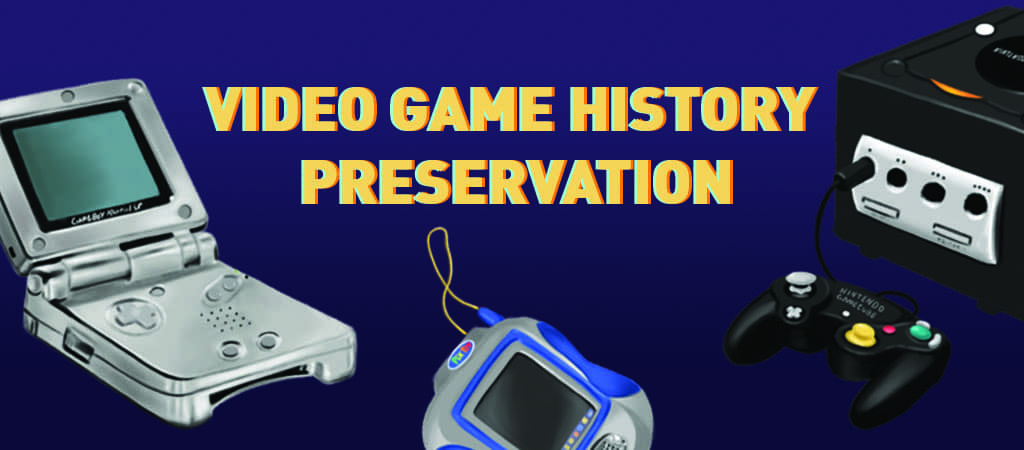
The first ever game system I had was Fisher-Price’s Pixter Color. It was marketed as a kid’s drawing tablet, but it had a limited range of cartridge games. My games of choice were drawing and education-focused Teen Titans and Fairly Odd Parents cartridges… that was, until I placed a magnet on the screen and irreparably damaged the system. As I got older, I graduated to my first console, the Nintendo Gamecube. I’m still lucky to have the Gamecube even if I rarely use it. However, it’s in thinking about my busted Pixter Color that I think of all the consoles and games that have been lost to history. Like all facets of history, video game history needs to be preserved. Serving as relics of the past, video games have a rich history worth remembering, because they will prove critical to the development of society.
Merriam-Webster defines video games as “an electronic game in which players control images on a video screen.” Increasing the scope of this definition, any form of interactive media that can be directly manipulated by a player could be considered a video game. The reasons why this distinction is so critical is because it highlights how expansive video games are as a medium, as well as highlights an important question about video games. What parts of video game history should be preserved in the canon of ‘video game history’ for years to come? For example, in elementary school, kids like me were obsessed with websites like Primary Games and Funbrain; these were sites that hosted web browser games, some of which I and my peers can still vividly remember. This is an integral part of my personal video game history, but the same could most likely not be said for the vast majority of other people. This is the key issue with video game history: there is a wealth of creativity within the video game genre that deserves to be preserved and remembered for years to come.
There are some clear choices that come to my mind: The Nintendo Wii, Super Mario Bros., The Legend of Zelda… Pretty much any Nintendo property could justifiably be preserved as video game history. Hell, pretty much any physical artifact of video games, consoles, games, hardware, etc. could justifiably be preserved. Where does that leave events that have shaped video games through the year, such as the 1993 Video Game Violence congressional hearings over games like Mortal Kombat, which lead to the video game ratings system that is recognized today? How about the 1983 video game crash that almost completely destroyed the video game industry? Important events such as these shape the culture around gaming just as much as the actual games themselves, but you’d be hard pressed to find these events mentioned in history textbooks.
The other question is, what deserves to be preserved in video game history? Should we include historically terrible games like E.T. the Extra-Terrestrial for the Atari 2600 when it’s considered to be one of the worst games of all time? Do we allow a game like Custer’s Revenge, a game that, not only just a bad video game, is just flat-out racist and sexist, to be discovered by future generations? The answer isn’t really clear; including both could be seen as important cautionary tales for developers, but would including terrible games be more important than including genuinely amazing games, or even just-ok-games?
Theoretically, there should be room for every game, console, artifact, and event to be included in the canon of video game history, but in actual practice it is nearly impossible to do that considering that many games have already been lost. Two of the most famous examples are the mobile game Flappy Bird and Konami’s playable teaser of the cancelled Silent Hills game, aptly titled P.T. While Flappy Bird took the world by storm with its maddeningly difficult but simplistic gameplay, not even a year after the game’s release, it was taken down from all mobile app stores. The game spawned several duplicates and devices with the game installed were sold on EBay for hundreds of dollars. P.T. has a similar story; as previously mentioned, the game was released digitally as a teaser for the new Silent Hill game, to be directed by Hideo Kojima and Guillermo Del Toro. Upon the teaser’s release it received critical acclaim, but Kojima soon left Konami, and as a result, the company cancelled the game and removed P.T. from all digital marketplaces. This rendered the game virtually unplayable for anyone who had not previously downloaded it. Similar to Flappy Bird, P.T. has been recreated a handful of times and consoles with the game installed were sold for hundreds on eBay. The major takeaway of these stories is that, even though copies of the games still exist, the games themselves are considered “lost”because of the extremely rare chance of being able to obtain the games in their original form. They survive essentially only in anecdotes and myths.
Another issue that needs to be considered in regards to preservation of the physical artifacts. As companies start moving away from the production of old consoles, there will inevitably be a decrease in the number of working consoles left. As another personal example, I own a Nintendo GameBoy Advance SP. While, in the grand timeline of video games, it’s a relatively new system, the fact that Nintendo has ceased production of the console and its accessories could render a working GameBoy extinct if there weren’t people dedicated to its preservation. Fortunately, dedicated collectors and preservationists of video games have been working to keep history alive.
One of the premier institutions in video game preservation is the National Videogame Museum in Frisco, Texas, which was founded by three avid collectors named Joe Santulli, Sean Kelly, and John Hardie. I had the privilege of interviewing John Hardie about the museum and his thoughts on video game preservation. The museum itself boasts a giant range of not only consoles and games, but also merchandise that is derived from video games. According to Hardie, 85% of the museum’s collection is compiled from the personal collections of the three founders; however, the museum’s exhibits are always rotating. For example, the museum has started working to display local collections from people in the DFW area. Hardie believes that it is important to showcase the collections of locals as a part of video game preservation, noting that“preservation is not just the games, it’s the people.” His understanding of video games’ historical significance is what underpins the entire National Videogame Museum.
Hardie also shares the same fears as I do, that the future of video game history could be lost more quickly than the past. As more and more companies decide to release games only on digital platforms, the collector’s ability to preserve their games dwindles. Once the system or the server is gone, virtually all the games on that platform are lost. It’s for this reason that Hardie believes companies have a duty to preserve their games better.
The issue of video game preservation has already come up within the industry. . For example, publishing company ATLUS has recently announced that they will be making an effort to remaster or re-release their older games. This is due in part to their successful re-release of the hit JRPG Persona 4 Golden on PC, which sold over 500,000 copies in just one month. Though it is only one company, it is a step in the right direction for more companies realizing the benefits of preserving their older games.
However, it is important to remember the role of people in preserving video game history. We as gamers have a duty to try our best to preserve our personal collections, and share our personal histories. We can’t expect companies to do all (or any) of the preservation. By sharing our personal histories through video games, we are keeping society’s deep connection to video games alive, whether we know it or not; so don’t forget about that Pixter Color in your attic, even if you can’t turn it on anymore.

Comments